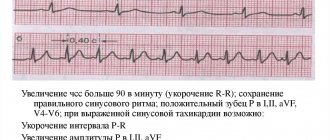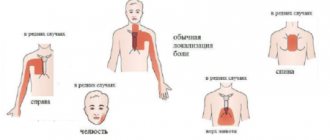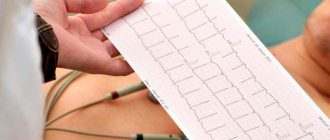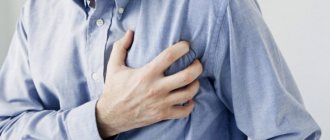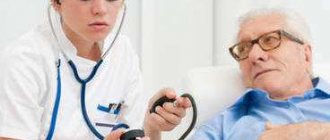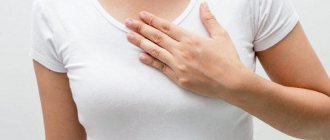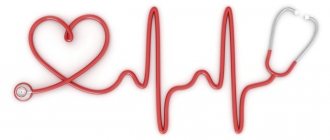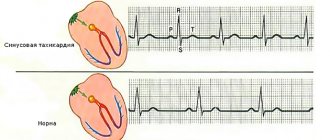An increased heart rate during a cold occurs due to fever, dehydration, or drinking caffeinated drinks. There are other factors: difficulty breathing, a hot and stuffy room, medications with a vasoconstrictor and bronchodilator effect. To count heart contractions, take a semi-sitting position and find the pulsation in the radial and carotid arteries.
Cause for concern arises when the rate is 120[/anchor]-130 beats per minute in a state of complete rest, but for heart patients, an increase above 100 is dangerous. For tachycardia, you need to drink enough water or herbal tea; for a fever above 38 degrees, take antipyretics; pain in the heart and palpitations - Corvalol drops, hawthorn tincture.
Classification, causes
There are physiological and pathological tachycardia.
Physiological occurs during physical activity and stress. At the same time, the level of adrenal hormones increases, which leads to an increase in heart rate.
Physiological tachycardia is an absolute norm for the body and goes away with the elimination of the provoking factor.
Pathological tachycardia occurs at rest and is a marker of cardiovascular, endocrine diseases, and inflammatory processes.
Its cause may be:
- Hyperthyroidism;
- Anemia;
- Heart defects;
- Myocarditis;
- Myocardial dystrophy;
- High blood pressure;
- Acute blood loss;
- Pheochromocytoma;
- Purulent processes (abscesses, phlegmon, peritonitis, meningitis);
- Dehydration with prolonged diarrhea, vomiting.
Tachycardias are divided into two large groups:
- Supraventricular;
- Ventricular
Effect on blood vessels
Despite serious pathological processes in the respiratory system, the greatest destructive phenomena during influenza occur in the heart and vascular bed. This is the main link in pathological processes. There is a significant increase in the permeability of the vascular walls, the mucous membranes of the heart valves and atria swell, and large-scale hemorrhages occur in the tissue of the lungs, heart, liver, kidneys and brain. In this case, the impact of dangerous toxins is most evident in the circulatory system:
- The vascular wall loses its contractile function, the muscle layer atrophies;
- The main organs become full-blooded, the heart, lungs, liver, kidneys are filled with venous blood poor in oxygen and nutrients;
- Blood plasma leaves the vessels, signs of plasmorrhagia become more active;
- Hemorrhage appears in the form of pinpoint hemorrhages on the surface of the mucous membranes of the heart sac, lining the inside of the heart - the epicardium and pericardium.
- Blood moves more slowly than usual, which increases the risk of clots and blood clots;
- Impaired hemodynamics, oxygen deficiency, and lack of vital nutrients lead to dystrophic processes in the heart muscle;
- Intoxication of the centers of the brain, the most important nodes of the central and autonomic nervous system leads to disruption of the innervation of the heart, in particular the legs of His, which in turn leads to disturbances in heart rhythm.
Considering the general condition of the body, depleted by quite a variety of manifestations of viruses and pathogens, infections in the vast majority of cases manifest tachycardia - an increase in the rhythm of contractions. During the recovery period, it may be accompanied by atrial fibrillation or ventricular fibrillation.
Supraventricular tachycardia
This definition means three or more consecutive contractions of the heart with a frequency above 100 per minute, and the cells of the sinus node, atrial myocardium and atrioventricular junction participate in the process.
In turn, supraventricular tachycardias are classified into:
- Sinus tachycardia;
- Sinoatrial reciprocal tachycardia;
- Atrial tachycardia (including atrial flutter);
- AV nodal reentrant tachycardia;
- Tachycardias with pre-excitation syndromes: orthodromic reciprocal tachycardia and antidromic reciprocal tachycardia;
- Atrial fibrillation.
Actions in case of such violation
When, during a cold, a person experiences an increase in heart rate and rapid work of the heart muscle, there is no need to panic. It is necessary to observe complete bed rest and also drink enough fluids during the day. Do not forget about taking antipyretic drugs. Such medications can not only defeat the infectious agent, but also normalize temperature indicators.
If rapid heartbeat during a cold occurs against a background of normal temperature, then antipyretics are replaced with antiviral drugs. They destroy pathogenic bacteria and block the development of the infectious process. Additionally assigned:
- vasoconstrictor medications;
- antioxidants that improve blood circulation in the body;
- cardiac glycosides;
- beta blockers to reduce stress.
Also, during treatment you should adjust your menu. You should avoid fatty and spicy foods, as well as drinks that contain caffeine. It is imperative to take complexes that strengthen the immune system. Provide your body with a good night's rest, which should last at least eight hours.
You should engage in moderate exercise throughout the day. This will not only normalize the functioning of the heart muscle, but will also increase the body’s resistance to pathogenic bacteria. Another important point for a cold that occurs with the onset of a feverish state is sufficient compliance with the drinking regime. Against the background of dehydration, the volume of blood flow decreases, as a result of which the cardiovascular system works in an enhanced mode. Drinking plenty of fluids when you have a cold will help reduce the risk of heart palpitations.
Ventricular tachycardia
This type of violation includes:
- Paroxysmal monomorphic ventricular tachycardia;
- Fascicular left ventricular tachycardia;
- Continuously relapsing ventricular tachycardia;
- Polymorphic ventricular tachycardia.
As can be seen from the definitions, these forms differ in the source of pulse propagation.
Diagnostics
When visiting a doctor if palpitations occur against the background of progression of ARVI, the doctor must carry out diagnostic measures aimed at identifying possible diseases of the heart and vascular system. The activities are as follows:
- Laboratory tests - urine and general blood test. This method allows you to detect a viral infection that could cause an increase in the number of pulse beats. Using a blood test, you can also identify other blood diseases that are in no way related to pathogenic microorganisms.
- Magnetic resonance imaging - involves taking pictures of the brain, based on the results of which the doctor can assess the condition of the blood vessels. In addition, it is possible to identify problems in the central nervous system. The heart muscle is also examined if the cold does not go away for a long time.
- An ECG is a way to determine the degree and type of work of the heart muscle. This method is the most popular and has high accuracy of results.
To get rid of an irregular heart rhythm during ARVI, you need to destroy the root cause of the cold, i.e. the virus that caused the inflammation. For effective treatment of colds it is recommended:
- compliance with bed rest;
- at elevated body temperature (more than 38.5 degrees), antipyretic medications should be taken;
- abundant fluid intake - it is best to replace standard coffee and tea with medicinal decoctions and teas, hot fruit drinks and compotes, and it is also advisable to include warm milk with honey in the diet;
- antiviral drugs to fight infection;
- fight against cough - take medications strictly as prescribed by the doctor, who determines the nature of the cough;
- gargling with a decoction of calendula and chamomile, but you can also use a saline solution;
- drugs for constricting blood vessels against a runny nose (as prescribed by the attending physician).
The connection between flu, colds and heart health
ARVI, like influenza, occurs when the body is infected with viruses. Clinical manifestations of ARVI:
- Increased body temperature;
- Weakness;
- General malaise;
- Runny nose;
- Nasal congestion;
- Sore throat;
- Aches in the joints.
With influenza, the course of the disease is characterized by high (>38 C) temperature from the first days of illness, headaches, and pain in the superciliary area.
For more accurate diagnosis, there are currently rapid flu tests that can be purchased at pharmacies.
Preventive and therapeutic recommendations
Physical activity and heavy activities are completely excluded during the treatment period. Otherwise, there will be an increase in pressure, with activation of an accelerated heart rate.
Time will be usefully spent walking, at a leisurely pace of about two kilometers, at least an hour every day. Anyone who does not follow the simplest recommendations risks ending up in an emergency room in the operating room. All this justifies the therapist’s prescriptions for the duration of treatment, both for simple colds and for influenza and other diseases.
Causes of tachycardia during ARVI
Intoxication caused by the pathogenic effect of the virus on the body can lead to rhythm disturbances:
- Fever. An increase in body temperature of 1 degree leads to an increase in heart rate by 10 beats per minute.
- Dehydration. It develops with the addition of vomiting, diarrhea (tachycardia with influenza), and with limited drinking (poor appetite). Under conditions of fluid deficiency, the volume of circulating blood decreases. As a result, the heart muscle needs to strengthen its work to ensure normal blood flow to tissues and organs.
Description of the causes and signs of the disease
An accelerated heartbeat not only brings discomfort. In addition to a rapid pulse, the patient may experience a number of symptoms with:
- complaints regarding unpleasant sensations in the heartbeat, with a characteristic “heart jumping out” of the chest, lack of air;
- sudden attacks, up to 200 beats every minute (paroxysmal form);
- occasionally inaccessibility to palpation of the pulse;
- fluttering of the heart muscle;
- pale skin, cold sweat;
- pulsation of the neck vein, if there is an atrioventricular paroxysmal form;
- a rare venous pulse, but a rapid arterial pulse, in the ventricular form.
If a cold is accompanied by a high fever, there is a very high chance of experiencing increased heart rate. Pathology can also manifest itself in cases of hyperthyroidism with anemia, intoxication, and acute vascular insufficiency. The list of diagnoses also includes cardiac pathologies with myocardial infarction, unstable angina, acute myocarditis and other diseases. Regardless of whether the problem was caused by a cold or another deviation from the normal state, restoration of the heart rhythm must be carried out as soon as possible. If desired, it is possible to prevent heart problems and complications by promptly reducing tachycardia during a cold using accessible methods.
Treatment
Treatment of colds comes down to the following:
- Abundant fluid intake, special solutions for oral rehydration. If it is impossible to drink liquids in large volumes (with the urge to vomit, for example), intravenous administration of saline solutions will be required.
- Rinsing the nasal passages with saline solutions.
- Antiviral drugs (for influenza).
- At temperatures above 38.5 C - antipyretics.
- Symptomatic therapy depending on the manifestations of ARVI: vasoconstrictor drops in the nose for a runny nose, gargling with antiseptic solutions for pharyngitis, expectorant medications for coughs.
- Painkillers for headaches. Typically, antipyretics have an analgesic effect.
- If the temperature persists for a long time, you must consult a doctor and take a chest x-ray to exclude or confirm bronchitis or pneumonia.
- Taking vitamins and microelements is of an auxiliary nature.
If a patient is diagnosed with tachycardia, it is important to follow a regimen that will prevent an even greater increase in heart rate:
- Reduce physical activity;
- Maintain bed rest;
- Avoid psycho-emotional shocks;
- Consume liquid in large quantities;
- Ventilate the room regularly.
As for tachycardia, it is first necessary to establish the cause of the rapid pulse. For example, with hyperthyroidism, treatment will be reduced to a drug reduction in the production of thyroid hormones.
For patients with psychological problems and disorders, sedatives and antidepressants are helpful. Sessions with psychotherapists often help calm the nervous system and normalize heart rate. In this case, aromatherapy sessions and meditation have a beneficial effect.
Herbal tea with mint or milk also calms and normalizes the pulse.
If you experience a high heart rate, the following recommendations may help:
- Rinse your face and neck with cool water;
- Perform deep breathing movements while holding your breath while inhaling;
- Make pressing movements on the eyeballs;
- Massage movements in the projection of the sinocarotid sinus (when turning the head to the side in the fossa between the neck muscles).
Drug treatment can only be prescribed by a doctor (generalist, cardiologist). It will largely depend on the type of tachycardia.
Thus, sinus tachycardia, for example, does not require special treatment. Therapy in this case is aimed at eliminating the provoking factor (quitting smoking, drinking alcohol, coffee, strong tea, treating fever - in the case of ARVI).
Medicines are prescribed in cases where objective discomfort occurs and angina pectoris worsens. In this case, drugs from the group of β-blockers, calcium antagonists, and digoxin are prescribed.
To stop attacks of atrial tachycardia, intravenous administration of class I and class III antiarrhythmic drugs will be required, and transesophageal electrical stimulation of the atria is also possible.
One type of ventricular tachycardia, ventricular flutter, will require the use of electrical defibrillation.
As you can see, there are many ways to treat high heart rate; they should be prescribed by competent specialists.
Temperature with vegetative-vascular dystonia
Vegetovascular dystonia (VSD) has various clinical manifestations, among which hyperthermia is often found. Many people don't even notice a low-grade fever. It most often occurs with vegetative-vascular dystonia in adolescents and young adults.
Changes in temperature are associated with impaired thermoregulation. The hypothalamus is responsible for this process, and in most cases, experts do not detect any serious deviations in health.
Manifestations of vegetative-vascular dystonia disappear on their own after normalization of lifestyle, sleep and rest patterns, restoration of normal hormonal levels and functioning of the nervous system.
The hypothalamus sends specific signals to the thermoregulation center when the symptoms of vegetative-vascular dystonia worsen, and the pressure often increases and fear arises.
Typically, the temperature during VSD increases slightly and remains at the level of low-grade fever.
If additional headaches, dizziness, physical weakness, or decreased immunity appear, an examination is necessary.
Complications
Complications arise in the presence of initially pathological tachycardia due to a certain pathology. When acute respiratory infections occur, an increase in heart rate is superimposed on an already existing tachycardia.
This threatens the development of the following complications:
- Hypertensive crisis;
- Rhythm failure;
- Myocarditis.
Symptoms of myocarditis can sometimes occur under the guise of an acute respiratory viral infection: high fever, general malaise, weakness, aching joints. Shortness of breath and tingling in the heart area should alert you.
If the development of cardiac pathologies is suspected against the background of ARVI, an additional examination is prescribed:
- Blood and urine tests. This helps in identifying a viral infection as the cause of tachycardia.
- A biochemical blood test helps diagnose disorders of other organs and systems.
- Electrocardiogram. Assists in setting the type of tachycardia
- Ultrasound of the heart - if myocarditis is suspected
Cold problems
The heart is rightfully considered the most important organ on which not only our health, but also life in general depends. At the slightest malfunction of the driving engine, global destructive processes begin in the unique system of the human body. This is what requires special attention to one’s condition when acute seasonal respiratory diseases develop, among which influenza is the most dangerous.
The most common symptoms of this viral infection are low fever and tachycardia. Physiologically, this is a normal phenomenon, since the protective reserves of the immune system are depleted, and a significant imbalance of metabolic and other functions occurs. A rapid heartbeat against a background of + 35 0 C, or even lower, means that resistance to attacking viruses and bacteria is completely broken.
Read also: The doctor prescribed treatment for tachycardia
When an infectious agent is introduced into the body, intoxication and a pronounced allergic reaction occurs due to the production of biologically active substances by our body, released as a response to viral infections - prostaglandins, serotonin, histamines. With primary damage to the mucous membranes of the respiratory tract in the body, the following occurs:
- General intoxication of organs and systems;
- Destruction of epithelial cells of the bronchial tree and tracheal surface by toxins;
- Local death of epithelial cells;
- The nutrition of cells is disrupted, their outlines and sizes change, and their functions are disrupted.
- The layers of epithelium exfoliate en masse, and a desquamation effect is observed.
Prevention of tachycardia during colds
A diet with the exclusion of spicy, fatty, fried foods, limit the intake of coffee and caffeine-containing drinks. Caffeine stimulates the nervous and cardiovascular systems, provokes tachycardia and increased blood pressure. Combined with an increased heart rate due to a fever, this can negatively affect your heart function and overall health.
During the epidemic, limit visits to places with large crowds of people, wear a medical mask, and rinse your nose with saline solutions.
Taking immunomodulators is questionable. It is also necessary to observe a work-rest schedule, regularly ventilate the premises, humidify the air, especially during the heating period, regularly be in the fresh air, and play sports.
Quitting smoking, drinking alcohol and treating underlying diseases that cause tachycardia (hyperthyroidism, pheochromocytoma, anemia, purulent-inflammatory processes) are important.
Common problems of seasonal infections
In the cold months of the year, when autumn comes, followed by winter, almost every person suffers from the so-called cold. It can be completely unnoticed and occur with minimal smoothed symptoms. Or it can occur with severe intoxication, which manifests itself as pain throughout the body and other well-known unpleasant symptoms. They are the confirmation of the pathogenic process occurring as a result of infection by acute respiratory viruses and various highly virulent strains of influenza. Today, thanks to long-term research, it has been established that it is the reaction of the human body to the active activity of viruses and its poisoning by the products of their presence that is the most dangerous in terms of damage to the heart and vascular system.
Nowadays, all the achievements of science and applied pharmacology are aimed at defeating the most serious diseases that annually claim hundreds of thousands of lives across the planet. But neither oncology, nor tuberculosis and tropical infections can cause as many victims as a simple and seemingly banal flu. However, modern medical statistics rank it among the most dangerous infectious pathologies. When considering the possibility of complications of the heart and blood circulation in the form of tachycardia, it is necessary to take into account that a simple cold or the same flu has more than 250 different types, and their pathogens are prone to rapid mutations. No organism, even the strongest and most robust, is capable of naturally adapting and developing protective mechanisms against such danger.
